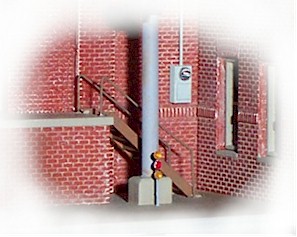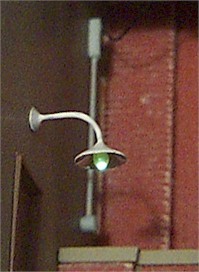Best viewed using:
Internet Explorer
or
Mozilla Firefox


Mounted on the rear brick wall, you'll see a typical watt-hour (electrical) meter box. The glass housing for the reading dials was made by gluing a small printed image on top of a larger aluminum reflector which was ten built up to a dome shape by applying 3-4 drops of Crystal Clear (#16001).

This is a photo of an early wall light creation using a piece of painted .010"
fiber optic as the lamp conduit with a shade and wall escutcheon glued to the
fiber (the light source is an LED on the other side of the wall lighting the
other end of the fiber). Here, we repeatedly dipped the end of the fiber in a
mixture of Amber and Crystal clear to form the shape of a light globe and
produce the color of an incandescent bulb. The light output was not very bright
and we have subsequently abandoned the use of fiber optic strands for anything
except direct-end viewing due to their huge light output loss.
As a very
successful alternative, we have repeatedly dipped a wired Nano LED in an
Amber/Crystal Clear mix and produced a (very bright) "light bulb".
Finally, we noted that this product comes in many different colors. However,
it is very easy to mix the different colors together to get the exact shade
needed for a particular application. Also the intensity of the color can be
"thinned" by adding Crystal Clear to the mix. This allows for near limitless
possibilities. Also, they have a Snow White (#16002) that is like liquid
white styrene. It is opaque but will allow light to shine through. If you
want a lens but want the light source dispersed, add some Snow White. When
dry, this product can be over-painted with acrylic paint.
Here's a handy tip: Cut a piece of clear acetate
(from the flat top of any blister-package) and place a drop of the different
colors of Gallery Glass® on the acetate. Once dried you can shine your light
source through it to see if the color is right for your application. This is
especially helpful if you're mixing to achieve a unique shade, because you
can note above the drop the color ratios used. Once you get the right
mixture, you're ready to mix and apply to the model.
Here's another: Want to mount an LED in a larger
hole? Dip the wired LED in Crystal Clear and allow to dry (you may have to
do this several times). This will not only increase and "round-out" the LED
shape, it will be totally insulated, and... the Crystal Clear will let
all of the light shine out.
Really
useful stuff!
Another example use is creating lenses for semaphores. Using a toothpick, this material's thickness (and surface tension) will allow the creation of "windows" like the Micro Scale product. Amber (#16020), Ruby Red (#16015) and Kelly Green (#16008) are perfect lens colors for this application.





















